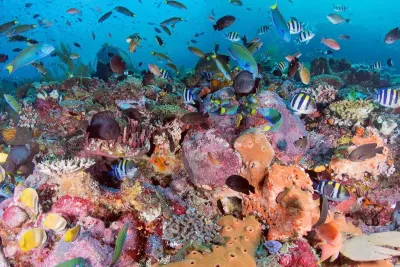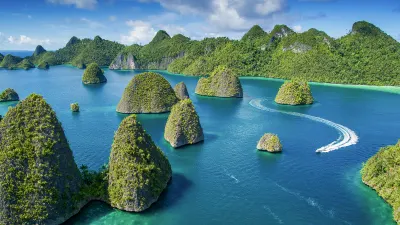Indonesia is one of the best places in the world to encounter manta rays and the country offers scuba divers and snorkelers alike, plenty of opportunities for memorable manta interactions. But which island and at what time of year should you visit for the best chances of a mesmerising manta ray encounter?
ZuBlu's travel experts have lived in Indonesia for a decade or more, and have dived the length and breadth of the country. We've spoken to dive guides, liveaboard owners and scientists, and combined our own experience of how the changing monsoon seasons influence the chances of encounters with manta rays to put together a guide revealing where you should travel to in Indonesia and the best time of year to maximise your chances of a manta ray encounter.
Diving with manta rays in Bali
Bali is one of the country’s better-known islands and is famous for its insta-worthy scenery, temples and diverse scuba diving destinations. Almost all of Indonesia’s most popular underwater experiences can be enjoyed somewhere along this beautiful coastline – including up-close manta ray encounters. These interactions take place around the smaller satellite island of Nusa Penida, located roughly 12-kilometres from Bali’s southeast coast. Not only are these experiences considered to be some of the best in Indonesia, but Nusa Penida's location makes them the most accessible manta dives in the entire country, reached on a day trip from Bali itself or from Penida and Lembongan.

Manta season in Nusa Penida, Bali
As well as being accessible, Nusa Penida’s manta ray encounters are also very reliable, with the rays frequenting several known sites along this island’s coast practically year-round. In fact, the only hiatus to sightings of manta rays occurs for a few weeks each year around the month of November, just before the wet season begins. While nobody knows exactly why many of the manta rays choose to disappear during this time, it is believed they could be seeking some extra privacy to mate. Conversely, manta ray numbers around Nusa Penida often peak around the month of May. It is also worth noting that, though the rays are present year-round, visibility is often at its best in the dry season from May to November, making this a popular time to visit. And you also have a great chance of sightings of mola mola as well at this time of year!
Diving with manta rays in Komodo
Komodo is an iconic Indonesian dive destination that is renowned for its thrilling, current-fuelled drifts - but it’s not just divers that are drawn to this exhilarating environment. Manta rays love the conditions experienced on many of the dive sites in Komodo, often using the fast-flowing water to help them filter-feed, or ‘hover’ above cleaning stations. As a result, divers flock from far and wide to visit this incredible corner of the Indonesian Archipelago – all hoping for an unforgettable encounter. While manta rays can show up on many sites within Komodo National Park, the most reliable sightings occur around the southern site of Manta Alley, as well as Karang Makassar and Mawan in the central region, and Cauldron in the north.

Manta season in Komodo
Komodo Park's manta ray population are known to make appearances at certain sites throughout the year. That said, between June and August – at the height of the dry season – many of these resident manta rays move to the south of the park in search of cooler, plankton-rich waters. Unfortunately, stronger winds make conditions in the south less than ideal at this time, meaning divers can rarely follow suit. Luckily, juvenile mantas seem to stay put and can still be seen around northern sites at this time, particularly Cauldron.
October through March is often considered the best time to dive with manta rays in Komodo. This is because the mature manta rays appear in larger numbers in central Komodo from October through December, and the famous southern site of Manta Alley is also easily accessible. Between December and February, the onset of the wet season brings blooms of plankton that lure a large number of migratory individuals into the region. At this time, manta rays can be seen almost anywhere within the park, with sometimes up to a dozen on a single site. Lucky divers may even witness the rare ‘manta mating train’ courtship ritual.
Diving with manta rays in Raja Ampat
Raja Ampat is among the best places in Indonesia to dive alongside manta rays, simply because the encounters are so reliable - and in some cases, unique! A large number of Raja Ampat’s remote manta ray population stands thanks to their stark colouring. While this species of ray typically have a black back and a white belly, around 40% of the mantas that frequent Raja Ampat are almost entirely black - so called melanistic forms - making them even more eye-catching. What’s more, certain sites around the Dampier Strait and Misool are renowned for delivering encounters with both reef and oceanic manta rays at the same time. Some of the best sites for witnessing oceanic manta rays include Blue Magic, Manta Ridge, Otdima, and Barracuda Point, as well as the southern sites of Eagle Nest, Four Kings, and Shadow Reef, also known as Magic Mountain.

Manta season in Raja Ampat
While divers are often well aware of Raja Ampat’s reliable manta ray experiences, many don’t realise that the encounters within this remote region are actually highly seasonal. Though chance sightings can occur throughout the year, the best time to dive with manta rays in Raja Ampat is undoubtedly during the northwest monsoon, which runs from October through to April. At this time of year, deep-water upwellings trigger plankton blooms that attract plenty of manta rays into Raja Ampat’s waters – with the highest numbers typically found from around December onwards. The northwest monsoon also offers some of the best all-round conditions, meaning the entire park is easily accessible and ensuring all of the most reliable spots can be visited, including remote southern sites.
Diving with manta rays in Sangalaki
Sangalaki is located within the distant Derawan Archipelago, around 40-kilometres off the coast of Indonesian Borneo. This isolated island receives far fewer tourists compared to the other iconic destinations in Indonesia, making a visit here all the more special. But, that’s certainly not to say Sangalaki is secret, because these biodiverse waters are believed by many to be among the best in the world for scuba diving and snorkelling. And, reliable manta ray sightings are among the most sought after underwater attractions on offer in this area. In fact, encounters aren’t just possible at Sangalaki, they’re highly probable, with reef manta rays regularly frequenting several sites on the island’s east coast.
Manta season in Sangalaki
One factor that makes manta sightings so common in Sangalaki is that the rays are thought to reside here year-round. Of course, encounters are never guaranteed, but sites such as Manta Avenue, Manta Parade and Manta Run more than live up to their name. Located along Sangalaki's north and east coasts, these dive sites all benefit from the same underwater topography which funnels the prevailing currents into the area, creating high concentrations of plankton. As a result, these manta rays routinely gather close to the surface in order to scoop up their favourite snack, allowing both divers and snorkelers to enjoy the show. And, when they’re not feeding, the rays also utilise several nearby bommies as cleaning stations, providing opportunities for divers to witness a range of behaviours.
Looking for the best time and place to encounter manta rays in another country?
Find YOUR ideal dive destination with ZuBlu's destination finder
Start planning your dive trip to Indonesia
Speak to a ZuBlu travel expert today

ZuBlu is the leading dive travel agency to search, compare and book scuba diving travel worldwide.





